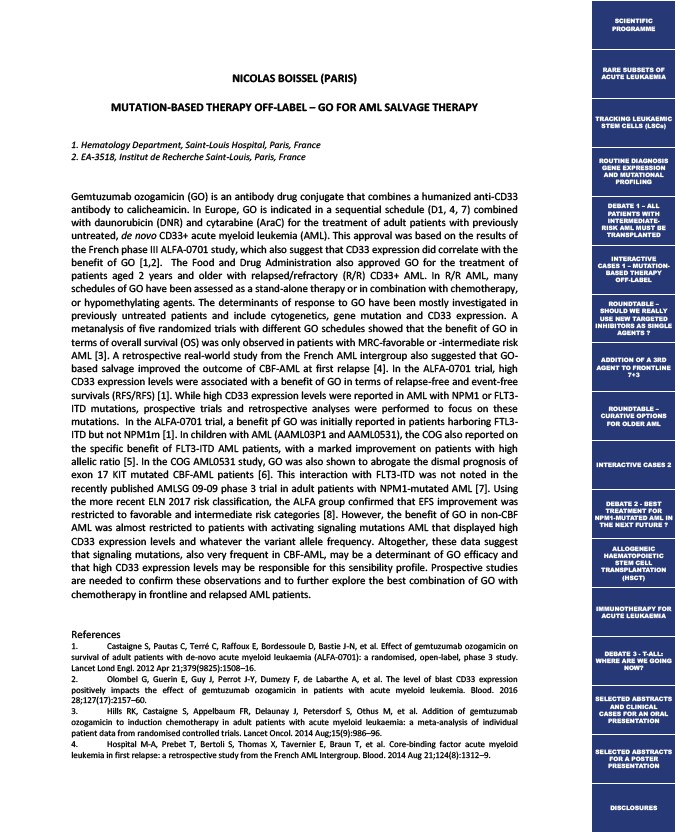
NICOLAS BOISSEL (PARIS)
MUTATION-BASED THERAPY OFF-LABEL – GO FOR AML SALVAGE THERAPY
1. Hematology Department, Saint-Louis Hospital, Paris, France
2. EA-3518, Institut de Recherche Saint-Louis, Paris, France
Gemtuzumab ozogamicin (GO) is an antibody drug conjugate that combines a humanized anti-CD33
antibody to calicheamicin. In Europe, GO is indicated in a sequential schedule (D1, 4, 7) combined
with daunorubicin (DNR) and cytarabine (AraC) for the treatment of adult patients with previously
untreated, de novo CD33+ acute myeloid leukemia (AML). This approval was based on the results of
the French phase III ALFA-0701 study, which also suggest that CD33 expression did correlate with the
benefit of GO 1,2. The Food and Drug Administration also approved GO for the treatment of
patients aged 2 years and older with relapsed/refractory (R/R) CD33+ AML. In R/R AML, many
schedules of GO have been assessed as a stand-alone therapy or in combination with chemotherapy,
or hypomethylating agents. The determinants of response to GO have been mostly investigated in
previously untreated patients and include cytogenetics, gene mutation and CD33 expression. A
metanalysis of five randomized trials with different GO schedules showed that the benefit of GO in
terms of overall survival (OS) was only observed in patients with MRC-favorable or -intermediate risk
AML 3. A retrospective real-world study from the French AML intergroup also suggested that GO-based
salvage improved the outcome of CBF-AML at first relapse 4. In the ALFA-0701 trial, high
CD33 expression levels were associated with a benefit of GO in terms of relapse-free and event-free
survivals (RFS/RFS) 1. While high CD33 expression levels were reported in AML with NPM1 or FLT3-
ITD mutations, prospective trials and retrospective analyses were performed to focus on these
mutations. In the ALFA-0701 trial, a benefit pf GO was initially reported in patients harboring FTL3-
ITD but not NPM1m 1. In children with AML (AAML03P1 and AAML0531), the COG also reported on
the specific benefit of FLT3-ITD AML patients, with a marked improvement on patients with high
allelic ratio 5. In the COG AML0531 study, GO was also shown to abrogate the dismal prognosis of
exon 17 KIT mutated CBF-AML patients 6. This interaction with FLT3-ITD was not noted in the
recently published AMLSG 09-09 phase 3 trial in adult patients with NPM1-mutated AML 7. Using
the more recent ELN 2017 risk classification, the ALFA group confirmed that EFS improvement was
restricted to favorable and intermediate risk categories 8. However, the benefit of GO in non-CBF
AML was almost restricted to patients with activating signaling mutations AML that displayed high
CD33 expression levels and whatever the variant allele frequency. Altogether, these data suggest
that signaling mutations, also very frequent in CBF-AML, may be a determinant of GO efficacy and
that high CD33 expression levels may be responsible for this sensibility profile. Prospective studies
are needed to confirm these observations and to further explore the best combination of GO with
chemotherapy in frontline and relapsed AML patients.
References
1. Castaigne S, Pautas C, Terré C, Raffoux E, Bordessoule D, Bastie J-N, et al. Effect of gemtuzumab ozogamicin on
survival of adult patients with de-novo acute myeloid leukaemia (ALFA-0701): a randomised, open-label, phase 3 study.
Lancet Lond Engl. 2012 Apr 21;379(9825):1508–16.
2. Olombel G, Guerin E, Guy J, Perrot J-Y, Dumezy F, de Labarthe A, et al. The level of blast CD33 expression
positively impacts the effect of gemtuzumab ozogamicin in patients with acute myeloid leukemia. Blood. 2016
28;127(17):2157–60.
3. Hills RK, Castaigne S, Appelbaum FR, Delaunay J, Petersdorf S, Othus M, et al. Addition of gemtuzumab
ozogamicin to induction chemotherapy in adult patients with acute myeloid leukaemia: a meta-analysis of individual
patient data from randomised controlled trials. Lancet Oncol. 2014 Aug;15(9):986–96.
4. Hospital M-A, Prebet T, Bertoli S, Thomas X, Tavernier E, Braun T, et al. Core-binding factor acute myeloid
leukemia in first relapse: a retrospective study from the French AML Intergroup. Blood. 2014 Aug 21;124(8):1312–9.
SCIENTIFIC
PROGRAMME
RARE SUBSETS OF
ACUTE LEUKAEMIA
TRACKING LEUKAEMIC
STEM CELLS (LSCs)
ROUTINE DIAGNOSIS
GENE EXPRESSION
AND MUTATIONAL
PROFILING
DEBATE 1 – ALL
PATIENTS WITH
INTERMEDIATE-RISK
AML MUST BE
TRANSPLANTED
INTERACTIVE
CASES 1 – MUTATION-BASED
THERAPY
OFF-LABEL
ROUNDTABLE –
SHOULD WE REALLY
USE NEW TARGETED
INHIBITORS AS SINGLE
AGENTS ?
ADDITION OF A 3RD
AGENT TO FRONTLINE
7+3
ROUNDTABLE –
CURATIVE OPTIONS
FOR OLDER AML
INTERACTIVE CASES 2
DEBATE 2 - BEST
TREATMENT FOR
NPM1-MUTATED AML IN
THE NEXT FUTURE ?
ALLOGENEIC
HAEMATOPOIETIC
STEM CELL
TRANSPLANTATION
(HSCT)
IMMUNOTHERAPY FOR
ACUTE LEUKAEMIA
DEBATE 3 - T-ALL:
WHERE ARE WE GOING
NOW?
SELECTED ABSTRACTS
AND CLINICAL
CASES FOR AN ORAL
PRESENTATION
SELECTED ABSTRACTS
FOR A POSTER
PRESENTATION
DISCLOSURES